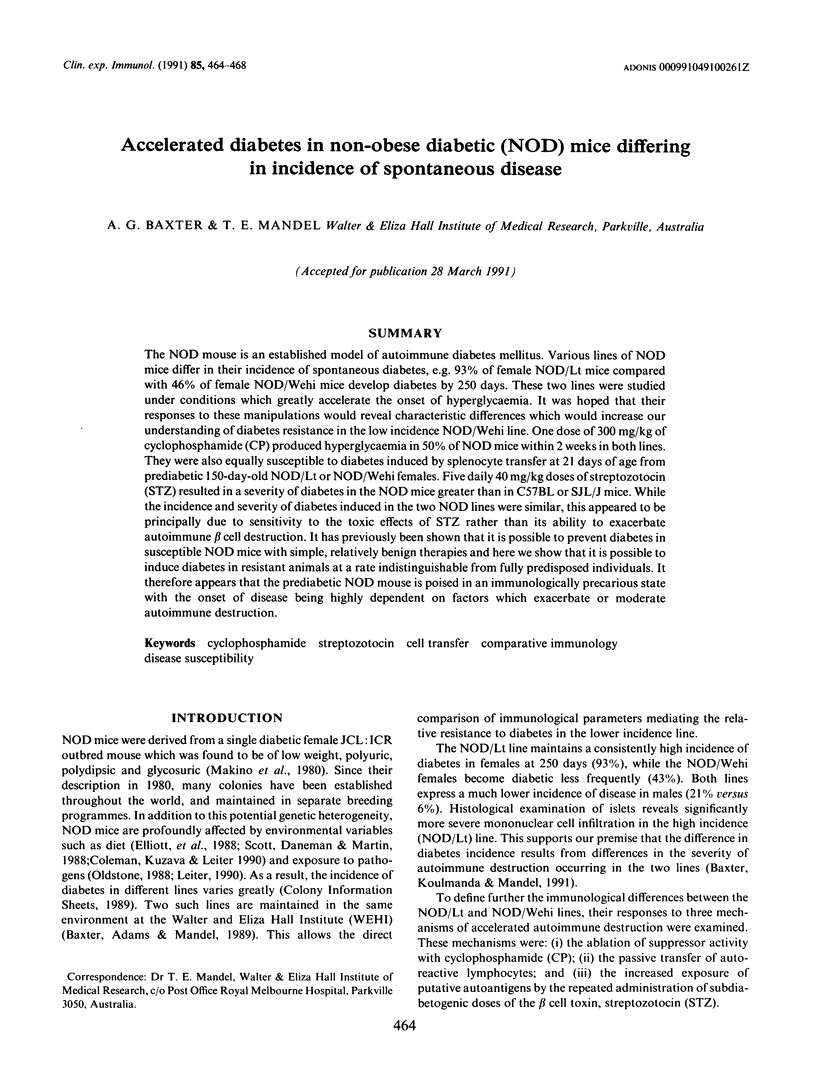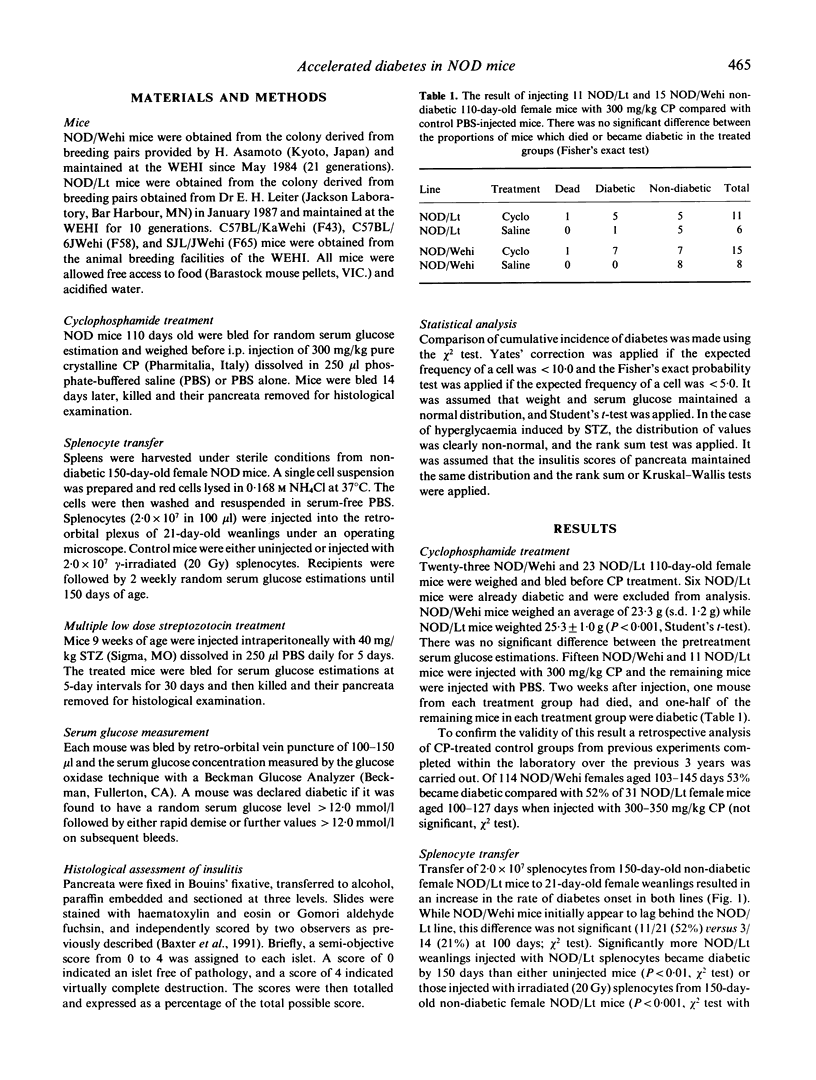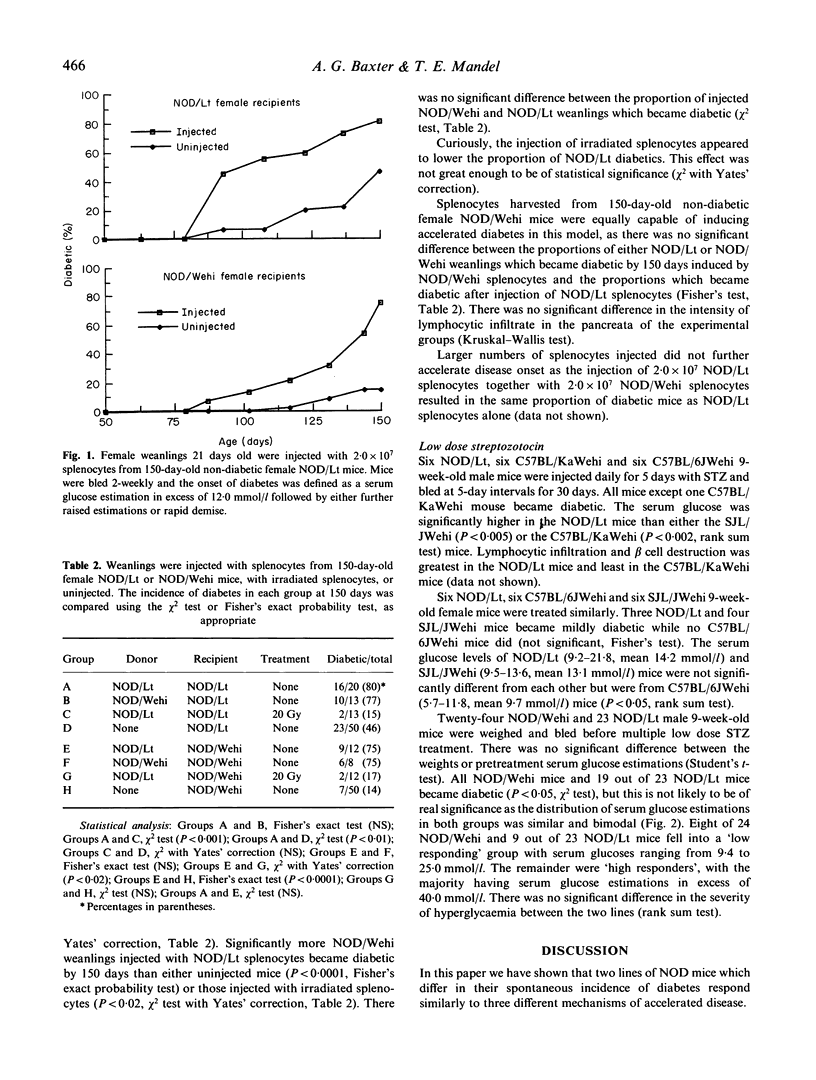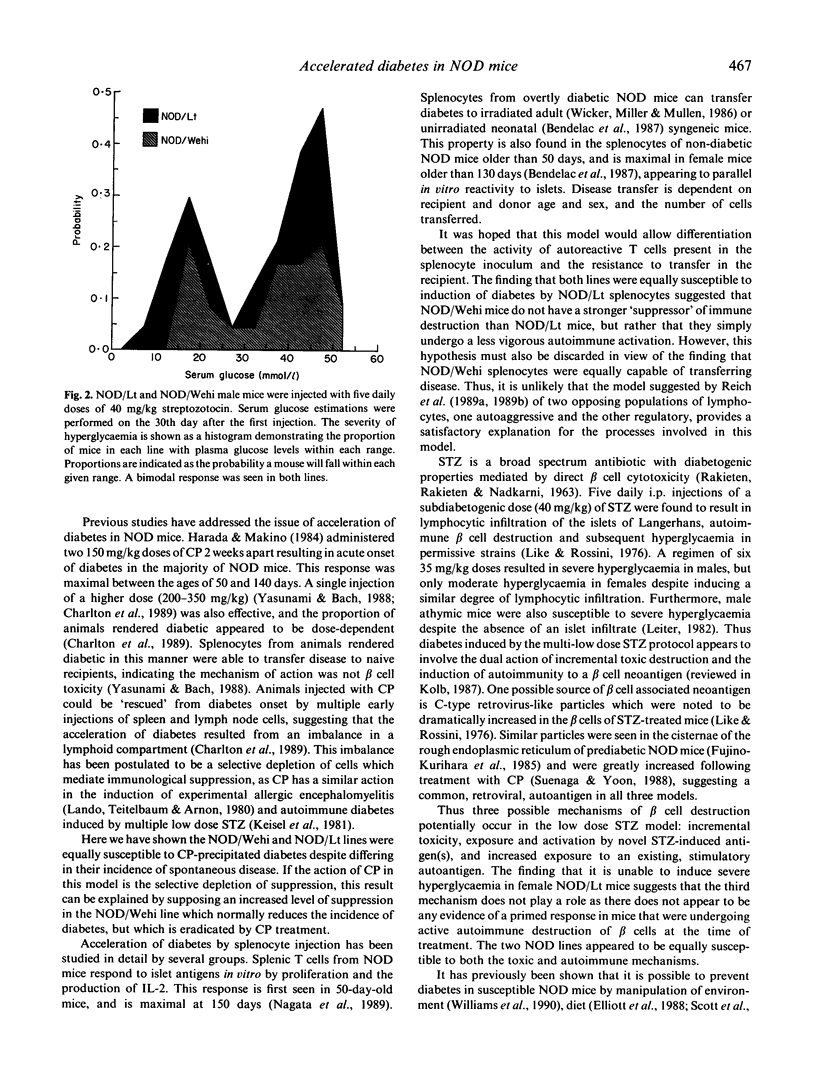Abstract
The NOD mouse is an established model of autoimmune diabetes mellitus. Various lines of NOD mice differ in their incidence of spontaneous diabetes, e.g. 93% of female NOD/Lt mice compared with 46% of female NOD/Wehi mice develop diabetes by 250 days. These two lines were studied under conditions which greatly accelerate the onset of hyperglycaemia. It was hoped that their responses to these manipulations would reveal characteristic differences which would increase our understanding of diabetes resistance in the low incidence NOD/Wehi line. One dose of 300 mg/kg of cyclophosphamide (CP) produced hyperglycaemia in 50% of NOD mice within 2 weeks in both lines. They were also equally susceptible to diabetes induced by splenocyte transfer at 21 days of age from prediabetic 150-day-old NOD/Lt or NOD/Wehi females. Five daily 40 mg/kg doses of streptozotocin (STZ) resulted in a severity of diabetes in the NOD mice greater than in C57BL or SJL/mice. While the incidence and severity of diabetes induced in the two NOD lines were similar, this appeared to be principally due to sensitivity to the toxic effects of STZ rather than its ability to exacerbate autoimmune beta cell destruction. It has previously been shown that it is possible to prevent diabetes in susceptible NOD mice with simple, relatively benign therapies and here we show that it is possible to induce diabetes in resistant animals at a rate indistinguishable from fully predisposed individuals. It therefore appears that the prediabetic NOD mouse is poised in an immunologically precarious state with the onset of disease being highly dependent on factors which exacerbate or moderate autoimmune destruction.
Full text
PDF




Selected References
These references are in PubMed. This may not be the complete list of references from this article.
- Baxter A. G., Adams M. A., Mandel T. E. Comparison of high- and low-diabetes-incidence NOD mouse strains. Diabetes. 1989 Oct;38(10):1296–1300. doi: 10.2337/diab.38.10.1296. [DOI] [PubMed] [Google Scholar]
- Baxter A. G., Koulmanda M., Mandel T. E. High and low diabetes incidence nonobese diabetic (NOD) mice: origins and characterisation. Autoimmunity. 1991;9(1):61–67. doi: 10.3109/08916939108997125. [DOI] [PubMed] [Google Scholar]
- Bendelac A., Carnaud C., Boitard C., Bach J. F. Syngeneic transfer of autoimmune diabetes from diabetic NOD mice to healthy neonates. Requirement for both L3T4+ and Lyt-2+ T cells. J Exp Med. 1987 Oct 1;166(4):823–832. doi: 10.1084/jem.166.4.823. [DOI] [PMC free article] [PubMed] [Google Scholar]
- Charlton B., Bacelj A., Slattery R. M., Mandel T. E. Cyclophosphamide-induced diabetes in NOD/WEHI mice. Evidence for suppression in spontaneous autoimmune diabetes mellitus. Diabetes. 1989 Apr;38(4):441–447. doi: 10.2337/diab.38.4.441. [DOI] [PubMed] [Google Scholar]
- Coleman D. L., Kuzava J. E., Leiter E. H. Effect of diet on incidence of diabetes in nonobese diabetic mice. Diabetes. 1990 Apr;39(4):432–436. doi: 10.2337/diab.39.4.432. [DOI] [PubMed] [Google Scholar]
- Elliott R. B., Reddy S. N., Bibby N. J., Kida K. Dietary prevention of diabetes in the non-obese diabetic mouse. Diabetologia. 1988 Jan;31(1):62–64. doi: 10.1007/BF00279136. [DOI] [PubMed] [Google Scholar]
- Fujino-Kurihara H., Fujita H., Hakura A., Nonaka K., Tarui S. Morphological aspects on pancreatic islets of non-obese diabetic (NOD) mice. Virchows Arch B Cell Pathol Incl Mol Pathol. 1985;49(2):107–120. doi: 10.1007/BF02912089. [DOI] [PubMed] [Google Scholar]
- Harada M., Makino S. Promotion of spontaneous diabetes in non-obese diabetes-prone mice by cyclophosphamide. Diabetologia. 1984 Dec;27(6):604–606. doi: 10.1007/BF00276978. [DOI] [PubMed] [Google Scholar]
- Kolb H. Mouse models of insulin dependent diabetes: low-dose streptozocin-induced diabetes and nonobese diabetic (NOD) mice. Diabetes Metab Rev. 1987 Jul;3(3):751–778. doi: 10.1002/dmr.5610030308. [DOI] [PubMed] [Google Scholar]
- Lando Z., Teitelbaum D., Arnon R. Induction of experimental allergic encephalomyelitis in genetically resistant strains of mice. Nature. 1980 Oct 9;287(5782):551–552. doi: 10.1038/287551a0. [DOI] [PubMed] [Google Scholar]
- Leiter E. H. Multiple low-dose streptozotocin-induced hyperglycemia and insulitis in C57BL mice: influence of inbred background, sex, and thymus. Proc Natl Acad Sci U S A. 1982 Jan;79(2):630–634. doi: 10.1073/pnas.79.2.630. [DOI] [PMC free article] [PubMed] [Google Scholar]
- Like A. A., Rossini A. A. Streptozotocin-induced pancreatic insulitis: new model of diabetes mellitus. Science. 1976 Jul 30;193(4251):415–417. doi: 10.1126/science.180605. [DOI] [PubMed] [Google Scholar]
- Makino S., Kunimoto K., Muraoka Y., Mizushima Y., Katagiri K., Tochino Y. Breeding of a non-obese, diabetic strain of mice. Jikken Dobutsu. 1980 Jan;29(1):1–13. doi: 10.1538/expanim1978.29.1_1. [DOI] [PubMed] [Google Scholar]
- Nagata M., Yokono K., Hatamori N., Shii K., Baba S. The presence of splenic T cells specific for islet cell antigens in nonobese diabetic mice. Clin Immunol Immunopathol. 1989 Nov;53(2 Pt 1):171–180. doi: 10.1016/0090-1229(89)90047-0. [DOI] [PubMed] [Google Scholar]
- Oldstone M. B. Prevention of type I diabetes in nonobese diabetic mice by virus infection. Science. 1988 Jan 29;239(4839):500–502. doi: 10.1126/science.3277269. [DOI] [PubMed] [Google Scholar]
- RAKIETEN N., RAKIETEN M. L., NADKARNI M. R. Studies on the diabetogenic action of streptozotocin (NSC-37917). Cancer Chemother Rep. 1963 May;29:91–98. [PubMed] [Google Scholar]
- Reich E. P., Scaringe D., Yagi J., Sherwin R. S., Janeway C. A., Jr Prevention of diabetes in NOD mice by injection of autoreactive T-lymphocytes. Diabetes. 1989 Dec;38(12):1647–1651. doi: 10.2337/diab.38.12.1647. [DOI] [PubMed] [Google Scholar]
- Reich E. P., Sherwin R. S., Kanagawa O., Janeway C. A., Jr An explanation for the protective effect of the MHC class II I-E molecule in murine diabetes. Nature. 1989 Sep 28;341(6240):326–328. doi: 10.1038/341326a0. [DOI] [PubMed] [Google Scholar]
- Scott F. W., Daneman D., Martin J. M. Evidence for a critical role of diet in the development of insulin-dependent diabetes mellitus. Diabetes Res. 1988 Apr;7(4):153–157. [PubMed] [Google Scholar]
- Suenaga K., Yoon J. W. Association of beta-cell-specific expression of endogenous retrovirus with development of insulitis and diabetes in NOD mouse. Diabetes. 1988 Dec;37(12):1722–1726. doi: 10.2337/diab.37.12.1722. [DOI] [PubMed] [Google Scholar]
- Wicker L. S., Miller B. J., Mullen Y. Transfer of autoimmune diabetes mellitus with splenocytes from nonobese diabetic (NOD) mice. Diabetes. 1986 Aug;35(8):855–860. doi: 10.2337/diab.35.8.855. [DOI] [PubMed] [Google Scholar]
- Williams A. J., Krug J., Lampeter E. F., Mansfield K., Beales P. E., Signore A., Gale E. A., Pozzilli P. Raised temperature reduces the incidence of diabetes in the NOD mouse. Diabetologia. 1990 Oct;33(10):635–637. doi: 10.1007/BF00400211. [DOI] [PubMed] [Google Scholar]
- Yasunami R., Bach J. F. Anti-suppressor effect of cyclophosphamide on the development of spontaneous diabetes in NOD mice. Eur J Immunol. 1988 Mar;18(3):481–484. doi: 10.1002/eji.1830180325. [DOI] [PubMed] [Google Scholar]


